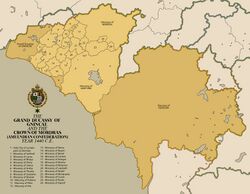Amulndian Confederation
| Amulndian Confederation | ||||||
| ||||||
| ||||||

Map of the Confederation c. 1440 | ||||||
| Nation | ||||||
| Official languages: | Amulni, Iqualni | |||||
| Politics | ||||||
| Government: | Theocratic Monarchy | |||||
| - Grand Ducassor: | Arthcenia (first) | |||||
| Legislature: | ||||||
| State religion: | ||||||
| Formation: | 1402 | |||||
| Dissolved: | 1491 | |||||
| Geography & Demographics | ||||||
| Economy | ||||||
| Currency: | Madare (Ꮇ)(?) | |||||
| [Source] | ||||||
The Amulndian Confederation, formally the Grand Ducassy of Gnincae and the Crown of Mordras (also known simply as the Confederation), was a bi-confederation of Amulna and Iqualna ruled by a common monarch that existed in the 15th century, from 1402 until 1491. It was established with the personal union of Grand Ducassor Ameran III Chasteuila of Gnincae and Queen regnant Serena Lagnenne of Iqualna, with Ameran III crowned as the Grand Ducassor Arthcenia of Amulndia. The creation of the state sparked a multi-century spanning dispute between the Crown of Mordras, traditionally possessed by elected Grand Ducassors of the Grand Ducassy of Amulna, and the dynastic descendents of Arthcenia and Serena of Iqualna, who claimed the right to the crown until the dynasty's depositon by the pretender Jalos Asica in 1783, easing tensions between the two states.
Though relatively prosperous during the reign of Arthcenia - especially with heightened spread of the religion of Astralism following the establishment of the Confederation - his death was followed with a bitter conflict between competing heirs with varying claims to the Amulndian throne, specifically the eight other Grand Ducassors of various Ducassies across Amlei, with the territory of Amulna still legally recognised as their rightful territory, and not that of a noble dynasty. This disputed legitimacy sparked a long period of political, military and economic decline, worsened with a seemingly exponential popularity of militant nationalist movements that grew across the multicultural Confederation, put ceaseless strain on the coffers and unity of the State and Crown. Its protracted weakness drove it to crumble in the wake of two successive partitions, the first in 1479 with the conquest of the historical regions of Esvkrassia and Palorina by the Chasteuilan Virassian Empire, aided in part by Chasteuilan-funded Virassian nationalists and a claim on the region of Esvkrassia as historical territory. The second came in 1491 with the split of Amulndia into the two nations of Amulna and Iqualna, with Amulna functioning as the continuing legal personality of the Grand Ducassy of Gnincae and the Crown of Mordras, despite Iqualna's own claims on the Crown of Mordras and control of significant portions of its historical territories.

